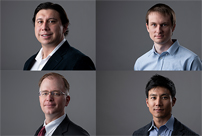Evidence builds that an early mutation made the pandemic harder to stop
A Covid-19 intensive care ward in Italy, early in the pandemic, NYT photo.
The mutation, known as 614G, was first spotted in eastern China in January and then spread quickly throughout Europe and New York City. Within months, the variant took over much of the world, displacing other variants.
For months, scientists have been fiercely debating why. Researchers at Los Alamos National Laboratory argued in May that the variant had probably evolved the ability to infect people more efficiently.
But a host of new research — including close genetic analysis of outbreaks and lab work with hamsters and human lung tissue — has supported the view that the mutated virus did in fact have a distinct advantage. (Full Story)
Los Alamos scientists say their new technology could cut methane emissions By 90%
Image from Forbes.
Lead scientist Manvendra Dubey and his two Los Alamos team members, Bryan Travis and Jeremy Sauer, have already spoken with several potential commercial partners interested in working with them to commercialize the technology. The team hopes that their software — a type of machine learning code called a “neural net” — will be adopted widely by the energy industry.
“This is probably the most meaningful thing I’ve worked on since graduate school,“ said Dubey in a phone interview, recalling his days as a PhD student in atmospheric chemistry at Harvard, where he studied stratospheric ozone depletion. (Full Story)
Also from Shale Magazine
Novel chemical process a first step to making nuclear fuel with fire
Microscopic image of cerium nitride foam, LANL photo.
Anew "combustion synthesis" process recently established for lanthanide metals—non-radioactive and positioned one row above actinides on the periodic table—could be a guide for the production of safe, sustainable nuclear fuels.
"Actinide nitride fuels are potentially a safer and more economical option in current power-generating systems," said Bi Nguyen, Los Alamos National Laboratory Agnew postdoc and lead author of research recently published in the journal Inorganic Chemistry, which was selected as an American Chemical Society Editors' Choice Featured Article. (Full Story)
Also from Lab Manager Magazine and Engineering and Technology Magazine
'Superbolts' are real, and they flash up to 1,000 times brighter than regular lightning
Photo from Live Science.
"We focused on superbolts that are substantially brighter than normal lightning — at least 100 times more energetic — and then looked at the top pulses above that threshold, said Michael Peterson, lead author on both studies and a remote-sensing researcher at Los Alamos National Laboratory.
The brightest superbolts tended to cluster in geographic regions where large thunderstorms are common, and superbolt appearance was associated with "long-horizontal lightning flashes that can span hundreds of kilometers, which have been recently termed 'megaflashes,'" Peterson said. (Full Story)
Also from Science Alert
Tracking and fighting fires on earth and beyond
The 2011 Las Conchas fire near Los Alamos, USFS photo.
Ateam from Los Alamos National Laboratory in New Mexico, introduced new developments to a computational fluid dynamics model that can incorporate fuels of varying moisture content. Many existing environmental models average the moisture of all the fuels in an area, but that approach fails to capture the variations found in nature, said chemical engineer Alexander Josephson, a postdoctoral researcher who studies wildfire prediction at Los Alamos. As a result, those models may yield inaccurate predictions in wildfire behavior, he said.
"If you're walking through the forest, you see wood here and grass there, and there's a lot of variation," said Josephson. Dry grasses, wet mosses, and hanging limbs don't have the same water content and burn in different ways. (Full Story)
AAAS and LANL announce 2020 Fellows
New Fellows, from left, David Chavez, Chris Fryer, Pat Fitch, Bob Williams and Marcelo Jaime. LANL photos.
Five Los Alamos scientists have been named Fellows of the American Association for the Advancement of Science (AAAS). Election as a AAAS Fellow is an honor bestowed upon AAAS members by their peers. Members have been awarded this honor by AAAS because of their scientifically or socially distinguished efforts to advance science or its applications.
“The range of science contributions that this year’s Fellows have made is an excellent example of the high quality and extensive impact of our national security science at Los Alamos,” said John Sarrao, Deputy Director for Science, Technology & Engineering. “We are honored to have these five researchers among the Laboratory community.” (Ful Story)
Also from the Reporter this week:
DisrupTECH features superior plastics recycling, smart software, predictive mapping
Winners of the LANL DisrupTECH awards, clockwise from top left, Juan Leal, Eric Davis, Tony Shin, and Neil Loychik, LANL photos.
Cutting-edge technologies ranging from more effective plastics recycling to using AI for systems monitoring were recently showcased by a select group of Los Alamos National Laboratory scientists to businesses and investment groups as part of the Laboratory’s annual DisrupTECH event.
“Part of the mission of Los Alamos National Laboratory is to transition technology that was developed here to the commercial sector so the public can benefit from it,” said Kathleen McDonald, acting director of the Feynman Center for Innovation, which is the tech-transfer division of the Laboratory and host of the event. (Full Story)
To subscribe toLos Alamos Press Highlights, please e-maillistmanager@lanl.govand include the wordssubscribe PressHighlightsin the body of your email message; to unsubscribe, includeunsubscribe PressHighlights.
Please visit us at www.lanl.gov













